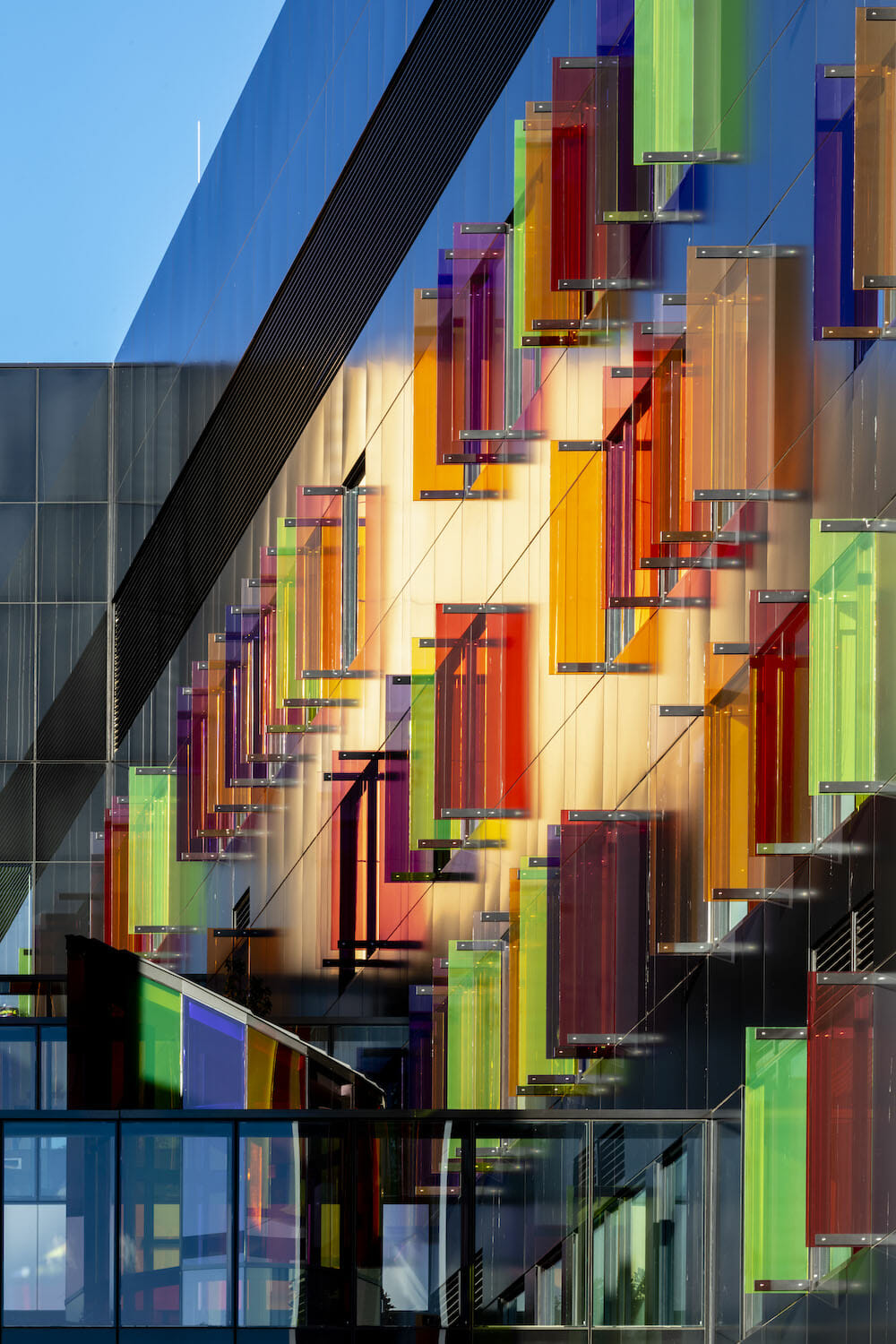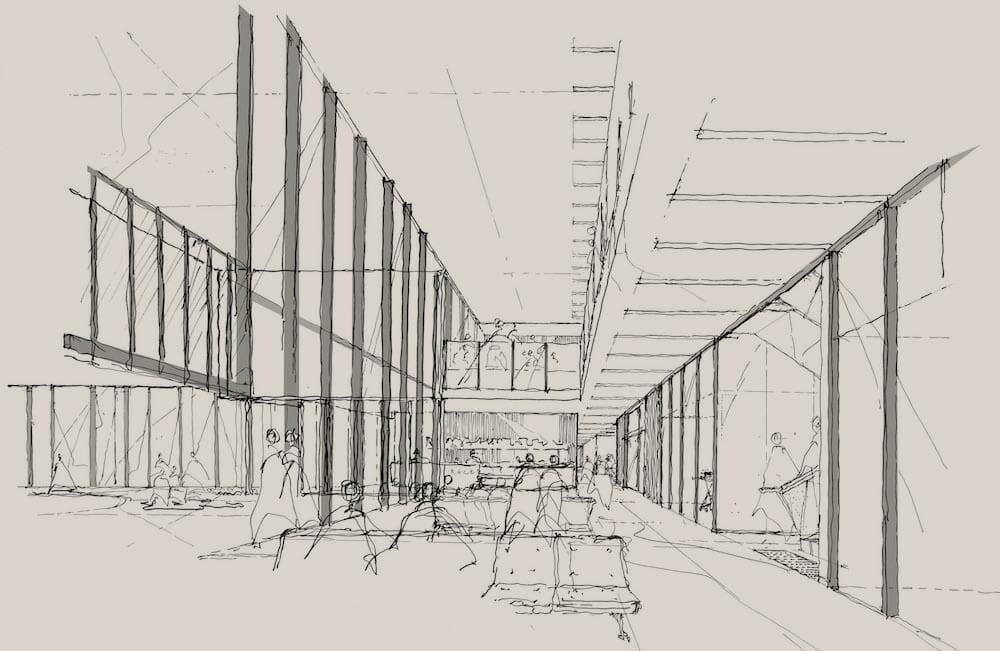How will COVID-19 Change Healthcare Design?

Blacktown Mount Druitt Hospital, Sydney, Australia. Completed 2020. Image © Brett Boardman.
By Diana Anderson, MD, MArch, Jacobs, Principal and Matthew Holmes, ARB, RIBA Jacobs, Global Solutions Director: Health Infrastructure
Now, nine months into the pandemic, there have been lessons learned from the immediate challenges of medical facility design, in addition to ongoing discussions of the long-term changes which are likely to impact how, where, and when we access our care.
The Here and Now: Short-term Design Changes
The pandemic has made it clear that our current healthcare facilities were not necessarily designed or configured to support the increased patient volumes. Therefore, controlling infection spread across the health workforce was difficult. Some of the capacity constraints included inadequate provision of donning and doffing space, engineering infrastructure that could not distribute the needed volume of life-saving medical gasses such as oxygen, and short supplies of personal protective equipment (PPE) and medical equipment. These capacity constraints required temporary response planning of pop-up accommodation, and rapid design and deployment of alternate care sites.
Reimagining Shipping Containers: Emergency Intensive Care Units
At the outset, as the COVID-19 pandemic progressed, hospitals around the world were grappling with shortages of Intensive-Care Unit (ICU) space to treat a growing number of patients in need of respiratory care and ventilators. One innovation focused on turning shipping containers into plug-in ICU pods, equipped with all the necessary medical equipment to treat intensive-care patients. The pod design focused on speed of deployment in addition to biocontainment and safety for patients and medical personnel. Pop-up care sites present clinical challenges and delivery difficulties; nevertheless, many of these initiatives have brought together architects, engineers, clinicians, and others in order to collectively innovate solutions.

Image © CURA
Clinician-inspired Design Changes
“Here-and-now” makeshift solutions by on-site clinicians brought to the forefront unforeseen design issues during a time of crisis. For example, the need to visualize high-acuity patients placed in standard hospital rooms yielded on-site alterations to solid room hospital doors in the form of cutting out sections to create vision panels. Medical equipment such as medication drips, IV tubing and lines, which are generally placed at the bedside in intensive care rooms, were moved out into the hallway to allow providers to make changes without the need to don and doff PPE and enter the patient room itself. It is conceivable that these on-site, clinician-led design changes will be considered as long-term requirements, with the potential to impact our minimum standard design guidelines.
Balancing Contagion and Connection
Clinical measures to control the spread of the virus have introduced new ethical and healthcare dilemmas for service providers, patients, and families. By decreasing contact to potentially or confirmed infectious patients, we must be cognisant of the fact that isolation and lack of human interaction also yield significant health risks, and therefore a balance must be sought. Birthing and dying experiences should always allow the option of loved ones being present in some capacity. Design ideas related to visitation in hospitals and long-term care sites have focused on digital/virtual networks and temporary visitation pods, which could allow socially distanced connections.
While open spaces with close proximities to one another are not necessarily safe during the current COVID-19 pandemic, in the future we hope to return to this model (see New Roma Hospital sketch). However, design changes ensuring that health space is convertible should infection or disaster arise are needed. Of note, visitation pods as described above could connect to existing lobby or entry spaces.
Looking Ahead: Long-term Design Strategies
While it is likely that post-pandemic life will return to a state of close physical proximities, including communal dining, socializing, and in-person workspaces, we will likely see healthcare space changes to allow for flexibility in the event of future infections. Waiting rooms, public lobbies and dining areas will require rapid subdivisions in the form of flexible designs to accommodate social distancing if needed. In addition, new and smart technologies will likely come to the forefront:
- Biocidal surfaces—materials that help kill pathogens, in addition to cleaning protocols;
- Touch-free technologies for commonly used surfaces such as sinks and doors;
- Smart furniture that could assist in the flexibility of space conversion to promote social distancing without major redesign or manpower to reconfigure.

The Future of Work in Healthcare
The means and methods by which clinicians and staff work within healthcare environments have been challenged by COVID-19. Changes related to how and where healthcare work is conducted are being accelerated by the rate of technology innovation, shifting demographics of the healthcare workforce, and the desire for choice and flexibility. The pandemic has been an inflection point in this trajectory, transforming clinical care models virtually overnight. This change was embraced through the rapid conversion to telehealth. In terms of challenges, IT infrastructure and connectivity to support extensive use of tele- and video-medicine will no doubt be a component of health design projects in the future.
Going forward, we will need to move beyond and shift the paradigm of healthcare work and place. Increased spacing, higher panels and more dividers just make facilities harder to maintain and make safe. A reevaluation of the value of place is needed to support how work really gets done and the needs of on-site personnel. Most likely, redefining the future of healthcare may include a mixed, distributed model consisting of central headquarters workspaces, with dispersed hubs and centers coupled with remote, virtual work. This model may allow for easier staff and patient access, flexible working, and organizational resiliency. Opportunities exist to create collaborative workspaces for staff that incorporate outdoor spaces and fresh air, focusing on well-being for those who provide care and the spaces that can promote periods of respite.
Will we return to prior models of work and care, or will our future clinical workplaces look and function differently?
Healthcare buildings will likely focus on outdoor spaces when possible, such as the courtyard of the proposed Tungaru Central Hospital—allowing wayfinding, socially-distanced gathering and fresh-air access to interior spaces. Open courtyards, operable windows, and fresh air are design strategies to mitigate the spread of infection. An additional design idea to maximize the efficiency of outdoor areas focuses on eliminating the need for corridors by having healthcare rooms open directly into outdoor courtyard spaces, facilitating infection control.

Paging Architects and Engineers
In the ongoing battle against COVID-19, it is imperative that architects and engineers continue to collaborate with health systems to address design improvements and operational changes, in order to make provisions that further bolster building resiliency. Some of these topics include:
- Optimizing operational efficiency;
- Energy and water conservation;
- Flexibility in the use of space, operations, and facilities (for example, provision of medical gases, isolation spaces, and negative pressure zones);
- Provisions for cutting-edge emerging technologies and solutions, such as automation;
- Use of simulation modeling and predictive analytics to better understand and model how a system could function in a pandemic or surge emergency.
Health and Wellness Beyond the Hospital
While healthcare facilities have been experiencing a surge in use during the pandemic, we cannot overlook the fact that many other building types such as schools, offices, and public/private spaces have remained vacant while people shelter-in-place and work from home. Buildings and engineering systems that are left idle can also present health risks and challenges that require ongoing mitigation to maintain occupant safety.
Unused buildings may experience water and air stagnation, uncontrolled humidity, and dry sanitary systems that could lead to health risks when occupants return. Significantly reduced water flows and prolonged stagnation have the potential to deteriorate water quality and significantly increase the risks of Legionella bacteria in the water system—safeguarding water quality within building water systems is paramount. Building mechanical systems, during times of limited use or no occupancy, may have periods of reduced outdoor air ventilation. In these cases, indoor air pollution has the potential to concentrate as chemicals, including volatile organic compounds (VOCs), which are released from indoor furnishings, carpets, building materials, and cleaning products. Humidity levels left uncontrolled can also contribute to mold growth.
These are all public health issues that if not addressed could negatively affect human respiratory systems and overall health, making architectural, engineering, and operational attention critically important.
External Environments
Managing infection control at a large scale requires new approaches to space design and use. The benefits of natural ventilation and external space provision have been resurrected as design strategies to reduce infection risk. In addition to infection prevention, the advantage of outdoor spaces includes promotion of physical activity and the ability to capitalize on nature’s restorative effects. These are opportunities for affirmative health and wellness design changes—benefiting staff by providing additional access to the outdoors, with balconies or porch designs providing a transitional space between indoors and out. Perhaps more care activities can take place in outdoor spaces going forward, depending on climate and location.
Te Nikau Hospital & Health Centre is an example of how open courtyards, operable windows, and fresh air are strategies to mitigate the spread of infection. Benefits of outdoor spaces also include mental health, staff respite, and additional access to light, views, and nature.

Te Nikau Hospital & Health Centre, New Zealand. Image © Sarah Rowlands.
Resiliency Beyond the Façade
Building system designs must also be resilient; for example, designing the mechanical system to allow the floor of a healthcare facility to be converted into pandemic or emergency mode, potentially having one air handling unit per floor. This configuration grants the hospital more flexibility to compartmentalize/isolate the floor space as needed. In addition, provisions for high-efficiency filters and trying to minimize any cross contamination of air flow are at the forefront of resilient building system considerations.
Toward Resilient Health Design
What COVID-19 has made clear is the need to increase and maintain resilient healthcare systems through a holistic approach to disaster preparedness and response. Resilient building systems are capable of absorbing, adapting, anticipating, and transforming when exposed to external threats, while retaining control over their area of responsibility, in order to deliver on their primary objectives and functions.
The pandemic has pushed us to consider both here-and-now design changes, and the long-term design considerations of coping with the next emergency or pandemic in our changed world. Recent trends have focused on delivering community models to support patient/provider interaction and collaboration around health and wellness, but COVID-19 has shifted the trend to keep people in smaller bubbles of operation and therefore necessitates smaller distributed amenities. Providing modifiable solutions will be paramount.
We must also consider resiliency beyond the scope of a pandemic, where the goal is to prevent the spread of infection. Other emergency scenarios may require rapid evacuation of patients and staff, such as in the case of a natural disaster. Overall preparedness is necessary to establish hospital readiness in a variety of situations and provide a proven response and recovery framework—before, during, and after an emergency. In addition, design solutions must also consider ongoing base population health needs, even in the midst of an acute pandemic.
Architects and engineers play a key role in the resiliency of short- and long-term healthcare. It is imperative that we continue to collaborate with health systems at the building and policy levels to address design issues, alongside public health challenges, in order to further bolster our built-environment resiliency and emergency preparedness. •
